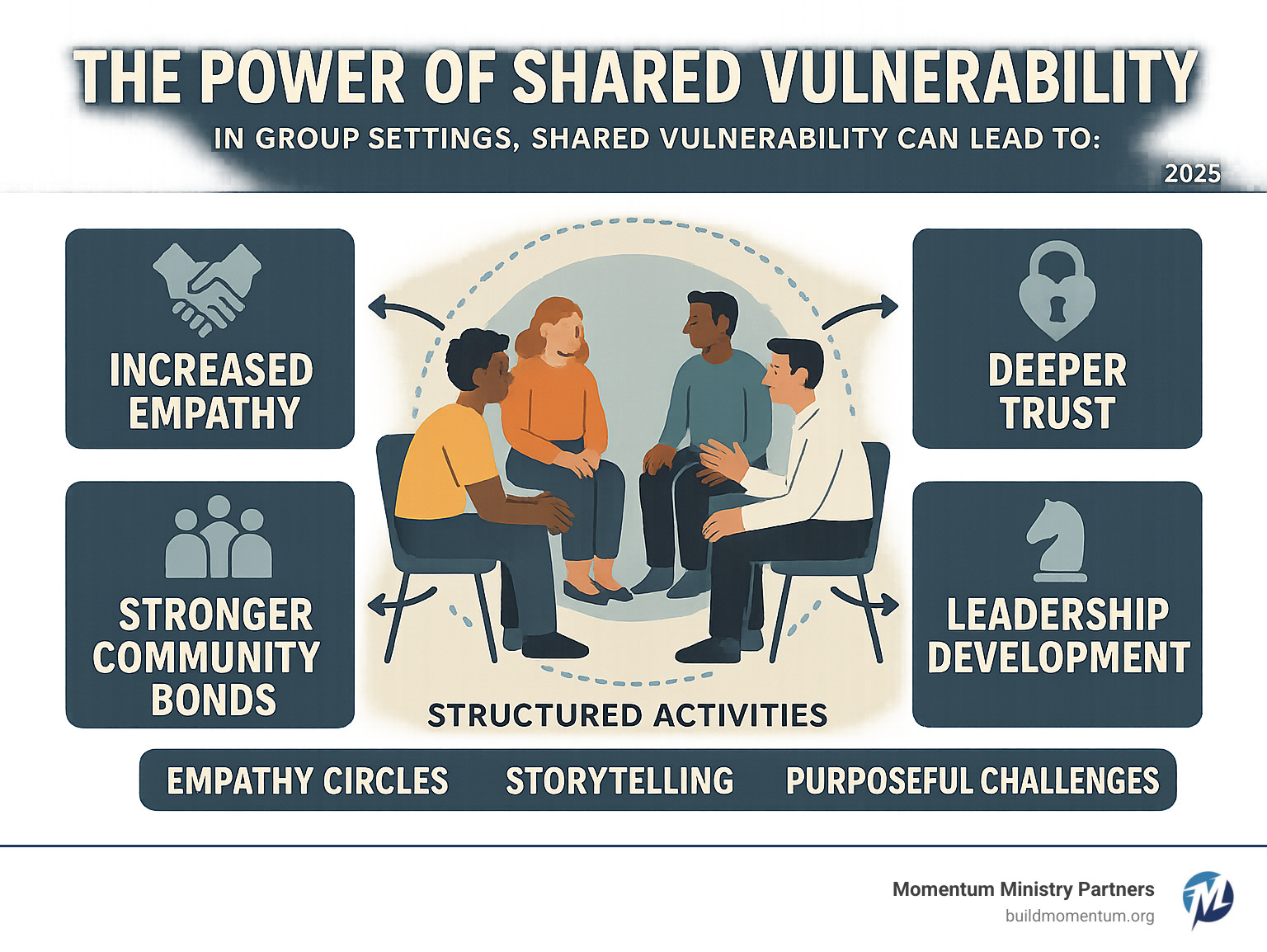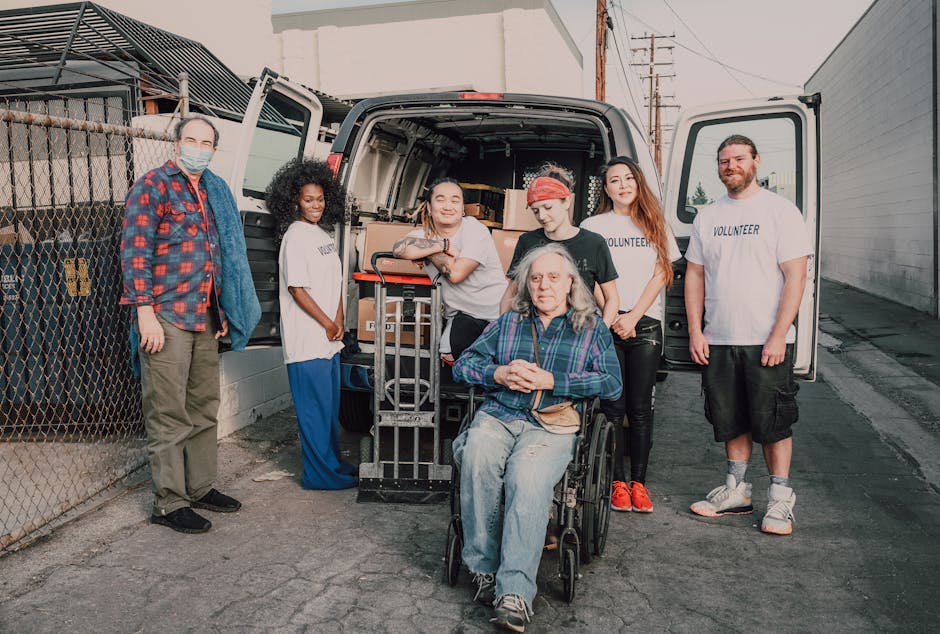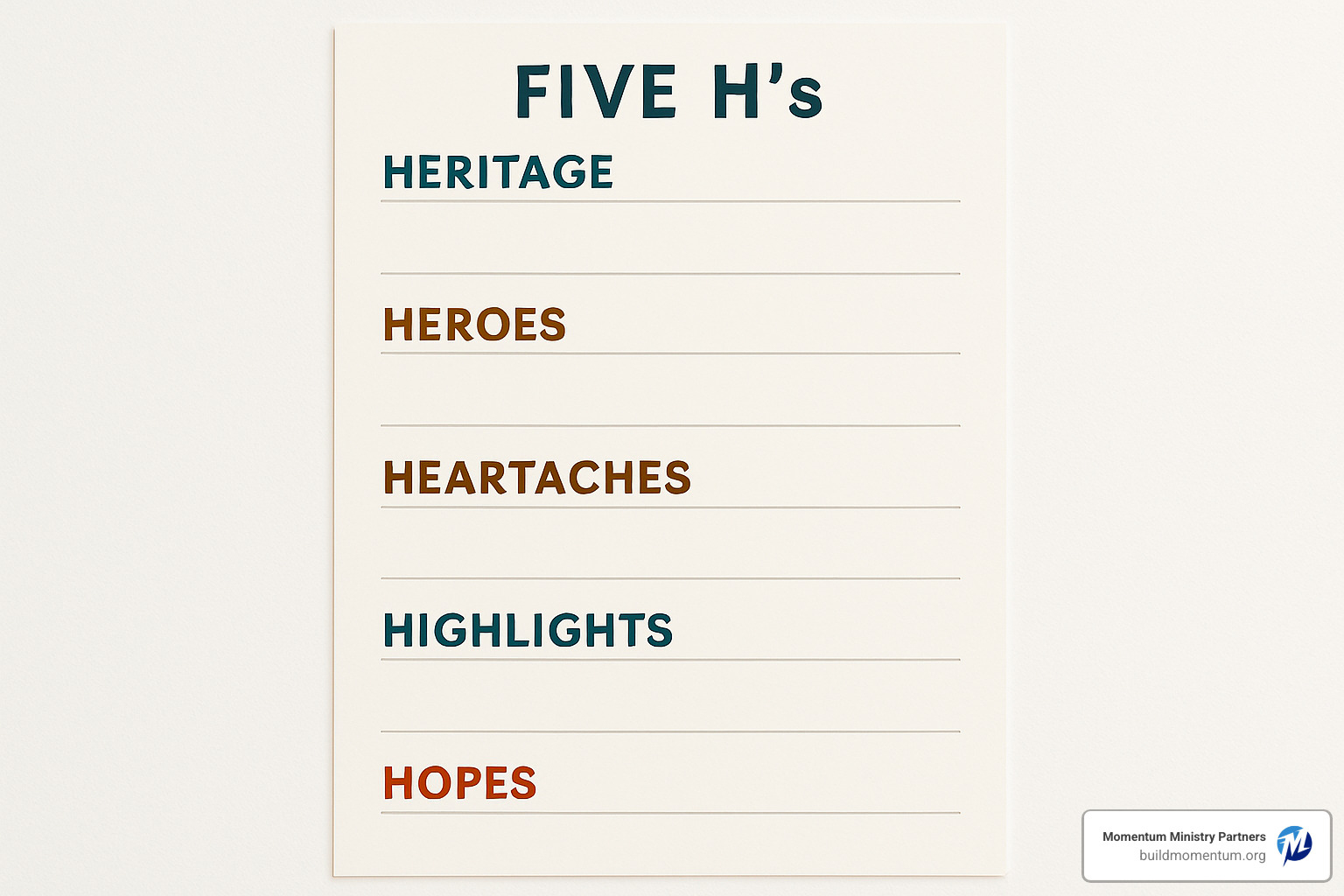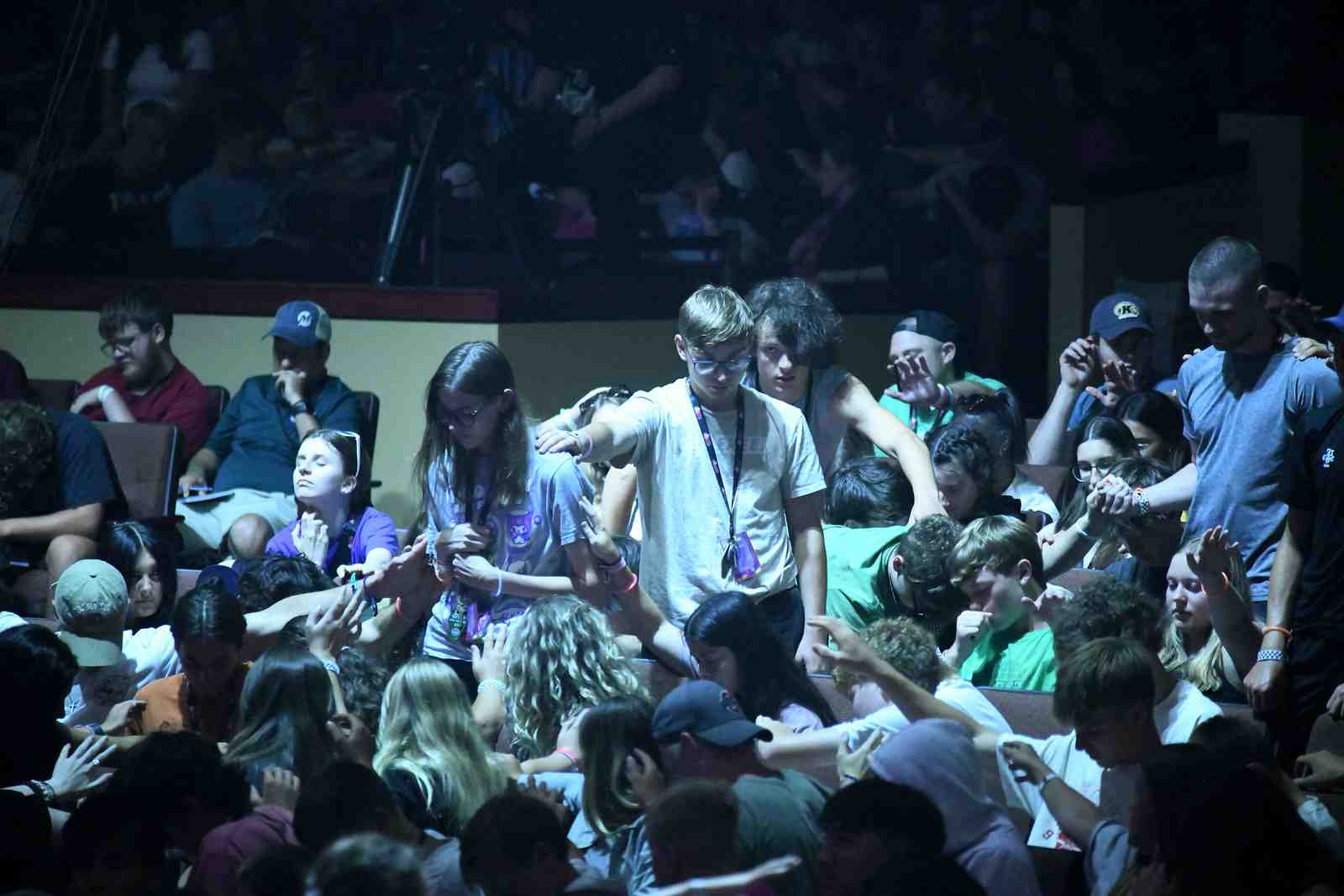Why Shared Suffering Activities Transform Communities
Shared suffering activities are structured experiences where groups intentionally engage with difficult emotions, challenges, or vulnerabilities together to build deeper connection and resilience. These activities range from empathy circles and storytelling exercises to meditation practices and community service projects that unite people through common struggles.
Top 7 Shared Suffering Activities:
- Empathy Circle – Structured listening and sharing in small groups
- The Five H’s Storytelling – Heritage, Heroes, Heartaches, Highlights, Hopes
- Group Tonglen – Breathing in pain, breathing out compassion
- Chair of Unwanted Feelings – Physical metaphor for processing emotions
- Purposeful Work Project – Team building through meaningful challenges
- Doom Circle – Structured feedback and critique sessions
- Burden Bearing – Practical support during difficult times
The research is clear: shared suffering creates powerful community bonds. When people experience hardship together – whether it’s a delayed flight, a challenging project, or deeper personal struggles – they form connections that shared interests alone cannot create. As one researcher noted, “Common suffering has a unique way of building community.”
But here’s what many miss: these connections don’t happen by accident. They require intentional structure, skilled facilitation, and safe environments where vulnerability becomes strength rather than weakness.
I’m Jeff Bogue, and over three decades of pastoral leadership at Grace Church and now as President of Momentum Ministry Partners, I’ve witnessed how carefully designed shared suffering activities can transform youth groups, small groups, and entire congregations. These experiences don’t just build empathy – they create the kind of authentic community that helps young people develop real leadership skills and spiritual resilience.

Why Bother? The Surprising Power of Shared Suffering
Compassion literally means “to suffer with.” That shift—from observing pain to entering it alongside someone—explains why shared suffering activities create bonds that casual conversation never will.
When we struggle alone, pain feels heavier and isolating. Yet multiple studies show that even tiny reminders of common identity (a shared sports team, a hometown) open up generosity and helpfulness. Structured vulnerability magnifies that effect: when a group intentionally sits with each other’s stories, the invisible walls of “us vs. them” crumble.
Psychologists call this the common-humanity principle. Naming hurt in a safe setting turns shame into connection and trains what researchers describe as the brain’s “empathy muscle.” Youth ministries that practice these skills see measurable gains in perspective-taking, kindness, and moral courage.
Put simply: hurt people often hurt people—but communities that learn to process pain together break that cycle. Shared suffering is not wallowing; it is guided movement from isolation toward hope, the very soil where spiritual resilience and Christ-like leadership grow.
7 Transformative Shared Suffering Activities for Your Group

After years in youth and adult discipleship, I’ve learned that the most powerful shared suffering activities are surprisingly simple and inexpensive. Each experience below turns individual challenge into collective strength while giving participants hands-on practice in empathy and leadership.
Choose an activity that matches your group’s readiness—start light, then move deeper as trust grows. Remember: these are not party games. They are intentional tools that move people from surface talk to soul-level community.
1. The Empathy Circle
The Empathy Circle stands out as one of the most powerful shared suffering activities for groups ready to explore deeper connection. Think of it as creating a safe harbor where people can share their storms while others simply listen and understand.
The magic happens in the structure itself. You’ll gather 3-6 people in a circle (four works best), then assign specific roles that rotate throughout the session. One person becomes the Speaker, choosing someone to be their Active Listener, while others serve as Silent Listeners who witness the exchange.
Here’s where it gets beautiful: the Active Listener doesn’t offer advice, solutions, or even their own stories. Instead, they become a mirror, reflecting back what they hear until the Speaker feels truly understood. “So what I’m hearing is that you felt abandoned when your friends didn’t include you…” The Speaker then clarifies or expands until they feel completely heard.
The feeling of being deeply understood is transformative. As one participant shared, “I enjoyed hearing about other people’s life experiences and seeing how productive the practice of active listening and feedback encourages authentic communication and healing.”
The process continues with roles rotating until everyone has experienced both speaking and listening. What emerges is something remarkable – people begin to realize their struggles aren’t unique, and their capacity for empathy grows stronger.
Ground rules make all the difference. Speakers should pause frequently to allow accurate reflection. Listeners focus entirely on understanding rather than problem-solving. The conversation continues until the Speaker explicitly says they feel heard and understood.
Research confirms what we’ve seen repeatedly in ministry contexts: empathy functions like a muscle that grows stronger with regular exercise. The Empathy Circle provides those essential “practice scales” that eventually create beautiful music in relationships.
For groups just beginning their journey into structured vulnerability, this activity offers a gentle yet powerful entry point. How to host an Empathy Circle provides additional resources for facilitators ready to implement this transformative practice.
2. The Five H’s Storytelling Exercise

Traditional icebreakers often feel forced and superficial. The Five H’s framework, developed through nearly 20 years of ministry practice, provides a structured way to move beyond surface-level sharing into genuine vulnerability and connection.
The Five H’s:
- Heritage – What type of family did you grow up in?
- Heroes – Who has impacted you in a significant way?
- Heartaches – What things have broken your heart?
- Highlights – What are you most proud of in your life?
- Hopes – What are your hopes for the future?
This progression is intentional. It begins with factual information (heritage), moves through relationships (heroes), enters vulnerable territory (heartaches), celebrates achievements (highlights), and concludes with future-focused optimism (hopes).
Implementation tips:
- Provide the framework in advance so participants can prepare
- Set time limits (2 minutes per H) to maintain engagement
- Use as an incentive for punctuality – those who arrive on time go first
- Frame the session within God’s grace to discourage unhealthy comparisons
The power of this exercise lies in its balance. As one youth leader observed, “Anna’s small group broke into tears and built unity through shared heartaches.” The vulnerability of sharing heartaches creates deep bonds, while the hope component ensures the experience ends on an uplifting note.
Uncensored Handling Difficult Topics Youth Group provides additional guidance for navigating sensitive conversations that may arise during this exercise.
3. Group Tonglen (Breathing In & Out)
Sometimes the most profound healing happens when we stop running from pain and learn to breathe through it together. Tonglen, a Tibetan meditation practice meaning “giving and receiving,” offers groups a powerful way to transform their relationship with suffering through shared breathing exercises.
This ancient practice works on a simple but principle: instead of avoiding difficult emotions, we intentionally breathe them in, process them through our hearts, and breathe out compassion and relief. When done in a group setting, it becomes one of the most transformative shared suffering activities available to ministry leaders.
Here’s how it works in practice: Participants sit comfortably in a circle and begin with natural breathing, simply noticing the sensations without trying to change anything. The facilitator guides them to visualize their breath flowing through their hearts and connecting them to the larger web of life around them.
The core of the practice involves breathing in suffering as heavy, hot smoke and breathing out relief and compassion as cool, bright light. This isn’t just about personal pain – participants are encouraged to include both individual struggles and global suffering in their practice. The group dimension adds incredible power because people experience their interconnectedness in a visceral way.
One practitioner beautifully described the experience: “Your heart that breaks open can hold the whole universe.” This captures the essence of what happens during group Tonglen – individual capacity for compassion expands through shared vulnerability.
Effective facilitation requires attention to rhythm and safety. Keep sessions to 10-15 minutes initially, maintaining a steady pattern of heavy inbreath and light outbreath. Encourage participants to avoid analyzing or judging what they experience. If no images or feelings arise, that’s perfectly normal – they can simply breathe through the numbness itself.
This practice proves particularly valuable for youth groups dealing with social issues, community tragedies, or overwhelming global concerns. It provides a constructive way to engage with difficult realities while building collective strength and resilience. Rather than feeling helpless in the face of suffering, participants find they can actively participate in healing.
The group mindfulness aspect creates bonds that extend far beyond the meditation session. When people breathe in collective pain and breathe out shared compassion together, they develop a deeper sense of community and mutual support.
A guide to the “Breathing Through” practice offers additional resources for facilitators wanting to explore this powerful approach to building group resilience through shared meditation.
4. The “Chair of Unwanted Feelings” Sculpture
Sometimes the most powerful shared suffering activities are the ones that make invisible struggles visible. The “Chair of Unwanted Feelings” sculpture does exactly that – it transforms internal emotional battles into something the whole group can see and understand together.
Picture this: you’re sitting in a circle with your group, and there’s one empty chair in the center. That chair represents all the unwanted thoughts and feelings we try so hard to avoid – anxiety, sadness, anger, shame. Now here’s where it gets interesting.
The setup is beautifully simple. After some guided breathing and reflection on a difficult experience, each person thinks about how they typically cope with hard emotions. Maybe you’re the type who throws yourself into work. Perhaps you scroll social media endlessly. Or maybe you just shut down completely.
Here’s the powerful part: each person gets to position their own chair in relation to that central “unwanted feelings” chair. Some people push their chairs as far away as possible. Others turn their backs to it. A few brave souls might move closer, but most create elaborate barriers and distances.
When everyone’s done arranging their chairs, something remarkable happens. The group can literally see how much energy and creativity we put into avoiding difficult emotions. The resulting sculpture tells a story – sometimes it’s a fortress of chairs protecting against the center, other times it’s a scattered mess of avoidance strategies.
But here’s what always stays the same: that central chair never moves. No matter how far we push our chairs away, no matter how cleverly we position ourselves, those unwanted feelings remain right where they started.
During the debrief, groups often have “aha” moments. They realize that their coping strategies – while understandable – sometimes cost more energy than the original emotion would have. The person who works 80 hours a week to avoid loneliness finds they’re more isolated than ever. The social media scroller realizes they’re comparing their pain to everyone else’s highlight reel.
This activity creates profound empathy because everyone can see that we’re all struggling with the same basic human challenge: what do we do with feelings we don’t want? The physical metaphor helps people understand that acceptance doesn’t mean giving up – it means stopping the exhausting fight against reality so we can focus on what actually matters.
The beauty of this sculpture is that it reduces shame and isolation while building practical wisdom about emotional regulation. When groups see their collective patterns laid out in chairs, they laugh, they cry, and they finally understand they’re not alone in their struggles.
5. A Purposeful Work Project
Nothing forges unity like tackling real problems together. Unlike contrived trust falls, a purposeful work project lets participants face authentic obstacles while pursuing a mission larger than themselves.
Pick work that matters and requires collaboration—building a wheelchair ramp for a neighbor, organizing a food drive, or leading VBS for younger kids. The task should be challenging but achievable, with outcomes that bless someone outside the group. As students coordinate rides, solve supply hiccups, and share sore muscles, they find each other’s strengths organically.
Key leadership tips:
- Define clear, measurable goals.
- Match roles to diverse gifts so everyone contributes.
- Debrief daily: What felt hard? Who stepped up? Where did we see God at work?
Projects like these convert stress into shared stories and lifelong confidence far better than any classroom lecture.
7. Structured Burden Bearing

Galatians 6:2 commands, “Bear one another’s burdens.” Structured burden bearing turns that verse into a practical plan:
- Abide first – stay rooted in prayer and Scripture so you serve from overflow, not emptiness.
- Show up – physical presence often speaks louder than perfect words.
- Listen well – understand before offering fixes.
- Pray immediately – don’t promise prayer later; do it now.
- Share Scripture wisely – comfort, don’t clobber.
- Point to the gospel – remind people of Christ’s hope.
- Meet tangible needs – meals, rides, childcare, lawn care.
By baking care into the group’s rhythm—rotating meal trains, crisis response teams, regular check-ins—small groups move from polite fellowship to genuine family.
Frequently Asked Questions about Shared Suffering Activities
How do we keep participants safe?
• Train facilitators in trauma awareness.
• Set clear ground rules (confidentiality, respect, opt-out anytime).
• Watch for overwhelm; pause or refer to professional help when needed.
How is this different from a gripe session?
Complaining gets people stuck. Shared suffering activities acknowledge pain and move toward empathy, prayer, and constructive action. The goal is resilience, not resentment.
Conclusion: Turning Shared Pain into Shared Purpose
When we step back and look at the bigger picture, shared suffering activities offer something our communities desperately need: a bridge from loneliness to belonging, from individual struggle to collective strength. These aren’t just feel-good exercises or temporary emotional experiences. They’re practical tools that create lasting change in how people relate to each other and process life’s inevitable challenges.
The change happens gradually but powerfully. First, participants find they’re not alone in their struggles. Then they develop the courage to offer support to others. Finally, they gain the skills to facilitate these kinds of meaningful conversations in their own spheres of influence. This progression from receiving to giving is where real leadership development begins.
At Momentum Ministry Partners, we’ve seen this pattern repeat itself across our network – from urban churches in Philadelphia to suburban congregations in Phoenix, from youth groups in Akron to college ministries in Los Angeles. The faces and stories change, but the underlying human need for authentic connection remains constant.
What makes these activities truly transformative is their intentionality. We’re not creating artificial suffering or manufacturing drama. Instead, we’re providing structured ways for people to process the real pain they already carry while building the skills they need to support others. This combination of vulnerability and competence creates resilient communities that can weather any storm.
The ripple effects extend far beyond the immediate group experience. Young people who learn to listen with empathy become better friends, family members, and future leaders. Adults who practice structured vulnerability model emotional intelligence for the next generation. Churches that accept these practices become known as places where people can bring their whole selves – struggles and all.
The journey from isolation to connection isn’t always comfortable, but it’s always worth it. When we create spaces where people can share their heartaches alongside their highlights, where breathing exercises help process collective pain, where practical service projects build lasting bonds, we’re doing more than building community. We’re developing the kind of leaders who can change the world.
Learn how to build stronger, more connected small groups and find additional resources for creating these transformative experiences in your own ministry context.
The goal isn’t perfection – it’s progress. Every empathy circle that helps someone feel truly heard, every burden-bearing moment that provides practical support, every structured activity that turns individual pain into shared purpose moves us closer to the kind of authentic community that reflects Christ’s love in tangible ways.







0 Comments